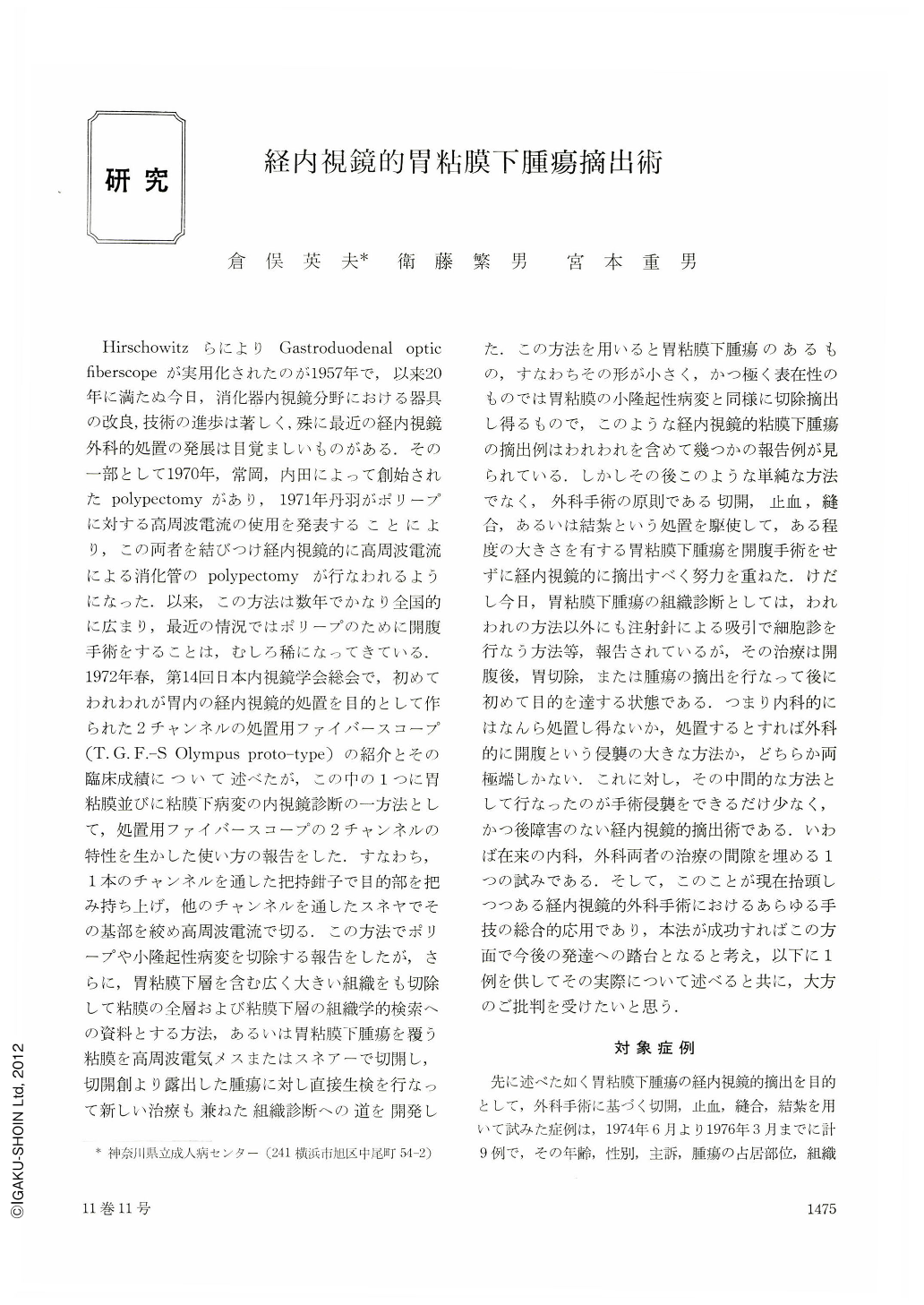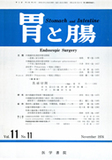Japanese
English
- 有料閲覧
- Abstract 文献概要
- 1ページ目 Look Inside
HirschowitzらによりGastroduodenal optic fiberscopeが実用化されたのが1957年で,以来20年に満たぬ今日,消化器内視鏡分野における器具の改良,技術の進歩は著しく,殊に最近の経内視鏡外科的処置の発展は目覚ましいものがある.その一部として1970年,常岡,内田によって創始されたpolypectomyがあり,1971年丹羽がポリープに対する高周波電流の使用を発表することにより,この両者を結びつけ経内視鏡的に高周波電流による消化管のpolypectomyが行なわれるようになった.以来,この方法は数年でかなり全国的に広まり,最近の情況ではポリープのために開腹手術をすることは,むしろ稀になってきている.1972年春,第14回日本内視鏡学会総会で,初めてわれわれが胃内の経内視鏡的処置を目的として作られた2チャンネルの処置用ファイバースコープ(T.G.F.-S Olympus proto-type)の紹介とその臨床成績について述べたが,この中の1つに胃粘膜並びに粘膜下病変の内視鏡診断の一方法として,処置用ファイバースコープの2チャンネルの特性を生かした使い方の報告をした.すなわち,1本のチャンネルを通した把持鉗子で目的部を把み持ち上げ,他のチャンネルを通したスネヤでその基部を絞め高周波電流で切る.この方法でポリープや小隆起性病変を切除する報告をしたが,さらに,胃粘膜下層を含む広く大きい組織をも切除して粘膜の全層および粘膜下層の組織学的検索への資料とする方法,あるいは胃粘膜下腫瘍を覆う粘膜を高周波電気メスまたはスネアーで切開し,切開創より露出した腫瘍に対し直接生検を行なって新しい治療も兼ねた組織診断への道を開発した.この方法を用いると胃粘膜下腫瘍のあるもの,すなわちその形が小さく,かつ極く表在性のものでは胃粘膜の小隆起性病変と同様に切除摘出し得るもので,このような経内視鏡的粘膜下腫瘍の摘出例はわれわれを含めて幾つかの報告例が見られている.しかしその後このような単純な方法でなく,外科手術の原則である切開,止血,縫合,あるいは結紮という処置を駆使して,ある程度の大きさを有する胃粘膜下腫瘍を開腹手術をせずに経内視鏡的に摘出すべく努力を重ねた.けだし今日,胃粘膜下腫瘍の組織診断としては,われわれの方法以外にも注射針による吸引で細胞診を行なう方法等,報告されているが,その治療は開腹後,胃切除,または腫瘍の摘出を行なって後に初めて目的を達する状態である.つまり内科的にはなんら処置し得ないか,処置するとすれば外科的に開腹という侵襲の大きな方法か,どちらか両極端しかない.これに対し,その中間的な方法として行なったのが手術侵襲をできるだけ少なく,かつ後障害のない経内視鏡的摘出術である.いわば在来の内科,外科両者の治療の間隙を埋める1つの試みである.そして,このことが現在抬頭しつつある経内視鏡的外科手術におけるあらゆる手技の総合的応用であり,本法が成功すればこの方面で今後の発達への踏台となると考え,以下に1例を供してその実際について述べると共に,大方のご批判を受けたいと思う.
We have succeded in the transendoscopic exstirpation of the submucosal tumor of the stomach in 6 out of 9 cases during June 1974 to March 1976. Two-channel gastrofiberscopes for treatment, T.G.F.-2S or 2D (Olympus Co.) including various suitable instruments were applied, such as high frequency knife, snare, scissors, forceps, clipapplicator, etc. and P.S.D.-Olympus Co. highfrecator insulated against electric shock was also used.
Now “transendoscopic exstirpation” means that this operation is to be performed with usual surgical procedures, instead of using a snare alone. The operation is performed almost in the same manner as exstirpation of subcutaneous tumor. Basic narcosis is applied with 30 mg of hydrochloric morphine atropine intromuscularly, and maintained with 35 mg hydrochloric pethisin intravenously. Two clips are attached to the base of the submucosal tumor for marking and identifying the location. These marking clips will help in identifying the exact location of the surgical field especially when hemorrhage obscures the field later on. A mixture of 2% procaine and epinephrine is injected into the area with an endoscopic needle in order to elevate the mucosa and separate it from the tumor. The surface mucosa is incised with a high frequency knife exposing the portion of tumor. Usually a small piece of tumor is removed for biopsy, and then we further proceed to excise the entire tumor.
The tumor is fixed with grasping forceps and is gently pulled up as sharp dissection is performed by means of scissors. This can also be accomplished by high frequency knife. The tumor is exposed as the dissection progresses. At last the tumor would simulate a broad-based polyp. The tumor is excised in the same way as polypectomy. The wound is irrigated with ice-cold irrigating solution mixed with epinephrine. Homostasis is accomplished with clips. Clips are also useful in approximating the mucosal edges for a large tissue defect caused by the romoval of the tumor.
During about one week after the operation, the patient is given no foods per os except several drugs for stomach ulcer with a small amount of water. With these drugs the patient has no complaint of stomachache. And glucose solution, Ringer's solution and protein, lipid synthetic solutions are given intravenously with many vitamines and hemostatic drugs. After one week the tissue defect begins to recover with granulation tissue. After third or four weeks since the operation, the surgical field appears to be replaced with scar tissue and all clips be extruded spontaneously.
Nine cases consisted of three males and six females. The eldest was 64 years old and the youngest was 44 years old. The location of the tumor were scattered over almost the entire stomach except prepyloric portion. Ratio of success were as follows: fornix 2/3, cardia 1/1, lesser curvature of corpus 1/2, greater curvature of corpus 1/1, angular part 1/1, anterior wall of antrum 0/1. The largest specimen was 3 . 0 cm in diameter. Histological diagnoses were as follows; leiomyoma 3, aberrent pancreas l, lipoma 1, solid heterotopic cystic formation of the stomach 1.
On the three unsuccessful cases on account of massive bleeding during operation, we analysed the reasons. No perforation and no batal accident were experienced until now.
This is the first report succeeding in the exstirpatation of gastric submucosal tumor transendoscopically.

Copyright © 1976, Igaku-Shoin Ltd. All rights reserved.


